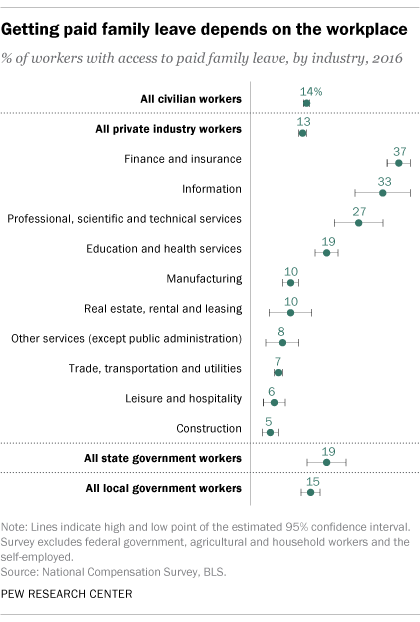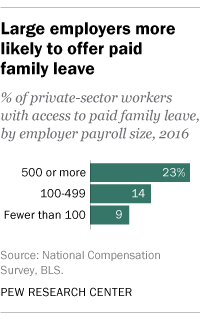Americans generally support paid family and medical leave, according to a new Pew Research Center survey. But relatively few workers have access to paid leave, and access varies considerably by industry and by the type and size of the employer.

In 2016, 14% of civilian workers had access to paid family leave, according to the National Compensation Survey (NCS), conducted annually by the federal Bureau of Labor Statistics. The share has grown only slightly since 2010 (the earliest year with directly comparable data), when paid family leave was available to 11% of civilian workers. By contrast, unpaid family leave is available to 88% of all civilian workers; that’s due in part to the federal Family and Medical Leave Act, which guarantees eligible workers up to 12 weeks of unpaid leave per year. (Workers may, of course, have access to both paid and unpaid leave.)
The NCS defines paid family leave as leave granted to an employee to care for a family member (including a newborn or adopted child, a sick child or a sick adult relative) in addition to any sick leave, vacation, personal leave or short-term disability leave that might be available. As used by the NCS, the term includes paid maternity and paternity leave.
California was the first state to establish paid family leave, in 2004, according to the National Conference of State Legislatures. Since then, four other states and the District of Columbia have enacted paid family leave laws. The measures in New Jersey and Rhode Island came into effect in 2009 and 2014, respectively; New York’s law is scheduled to take effect in 2018, and the D.C. law in 2020. (Washington state passed a paid-leave law in 2007, but it’s been on indefinite hold because of the lack of a funding mechanism.)
Access to paid family leave is more common for state government employees than for workers in the private sector, according to NCS data: In 2016, 19% of state government workers had access to paid family leave, versus 13% of private sector workers. Among local government workers, 15% had access to paid family leave. While the state and local government rates held steady between 2010 and 2016, the private sector rate has crept higher; it was 10% in 2010. (The NCS excludes federal government workers, agricultural and household workers and the self-employed.)
In private industry, access to paid family leave is most common in the finance and insurance, information, and professional, scientific and technical services sectors. More than a third (37%) of workers in the finance and insurance sector have access to the benefit. A third (33%) of information industry workers can access paid family leave, as can 27% of workers in professional, scientific and technical services. (Education and health-services workers have an access rate statistically similar to that of professional, scientific and technical workers.)
By contrast, workers in the construction and leisure/hospitality sectors have among the lowest rates of access to paid family leave, according to the NCS – 5% and 6%, respectively.

Perhaps not surprisingly, workers at larger private sector employers are more likely to have paid family leave available. According to the NCS data, 23% of workers at employers with 500 or more employees had access to the benefit (up from 17% in 2010), while only 9% of workers at employers with fewer than 100 employees do.
While Americans broadly favor the concept of paid family and medical leave, they’re divided over whether the federal government should require employers to pay their employees when they take family or medical leave (51%) or let employers decide for themselves to do so or not (48%), according to the new Pew Research Center report.
Compared with other policy issues, relatively few Americans see expanding paid leave as a top priority. In a separate survey the Center conducted in early January, 35% of adults said expanding access to paid family and medical leave should be a top priority for the president and Congress – placing it near the bottom of a list of 21 policy items, on par with improving the nation’s transportation infrastructure and dealing with drug addiction.
